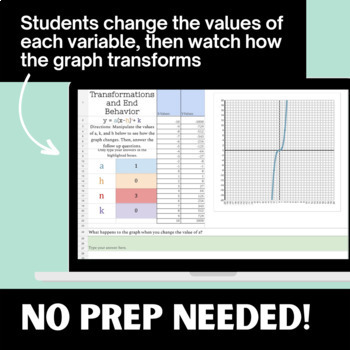Parent Functions and Transformations Digital Activity Bundle
Boldly Inspired Curriculum
287 Followers
Grade Levels
10th - 11th
Subjects
Resource Type
Standards
CCSSHSF-IF.A.1
CCSSHSF-IF.C.7c
CCSSHSF-IF.C.7e
CCSSHSF-BF.B.3
CCSSHSF-LE.A.3
Formats Included
- Google Drive™ folder
- Internet Activities
Pages
4 digital activities
Boldly Inspired Curriculum
287 Followers

Includes Google Apps™
This bundle contains one or more resources with Google apps (e.g. docs, slides, etc.).
Products in this Bundle (4)
Description
Help your students get a better understanding of function transformations with these interactive graphs! All of the Google Sheets are editable and pre-coded, so all you will need to do is share them with your students. Save 20% when you purchase the whole bundle!
Topics Included:
Absolute value functions
Cubic functions
End behavior
Exponential functions
Quadratic functions
Total Pages
4 digital activities
Answer Key
N/A
Teaching Duration
N/A
Report this resource to TPT
Reported resources will be reviewed by our team. Report this resource to let us know if this resource violates TPT’s content guidelines.
Standards
to see state-specific standards (only available in the US).
CCSSHSF-IF.A.1
Understand that a function from one set (called the domain) to another set (called the range) assigns to each element of the domain exactly one element of the range. If 𝘧 is a function and 𝘹 is an element of its domain, then 𝘧(𝘹) denotes the output of 𝘧 corresponding to the input 𝘹. The graph of 𝘧 is the graph of the equation 𝘺 = 𝘧(𝘹).
CCSSHSF-IF.C.7c
Graph polynomial functions, identifying zeros when suitable factorizations are available, and showing end behavior.
CCSSHSF-IF.C.7e
Graph exponential and logarithmic functions, showing intercepts and end behavior, and trigonometric functions, showing period, midline, and amplitude.
CCSSHSF-BF.B.3
Identify the effect on the graph of replacing 𝘧(𝘹) by 𝘧(𝘹) + 𝘬, 𝘬 𝘧(𝘹), 𝘧(𝘬𝘹), and 𝘧(𝘹 + 𝘬) for specific values of 𝘬 (both positive and negative); find the value of 𝘬 given the graphs. Experiment with cases and illustrate an explanation of the effects on the graph using technology.
CCSSHSF-LE.A.3
Observe using graphs and tables that a quantity increasing exponentially eventually exceeds a quantity increasing linearly, quadratically, or (more generally) as a polynomial function.




